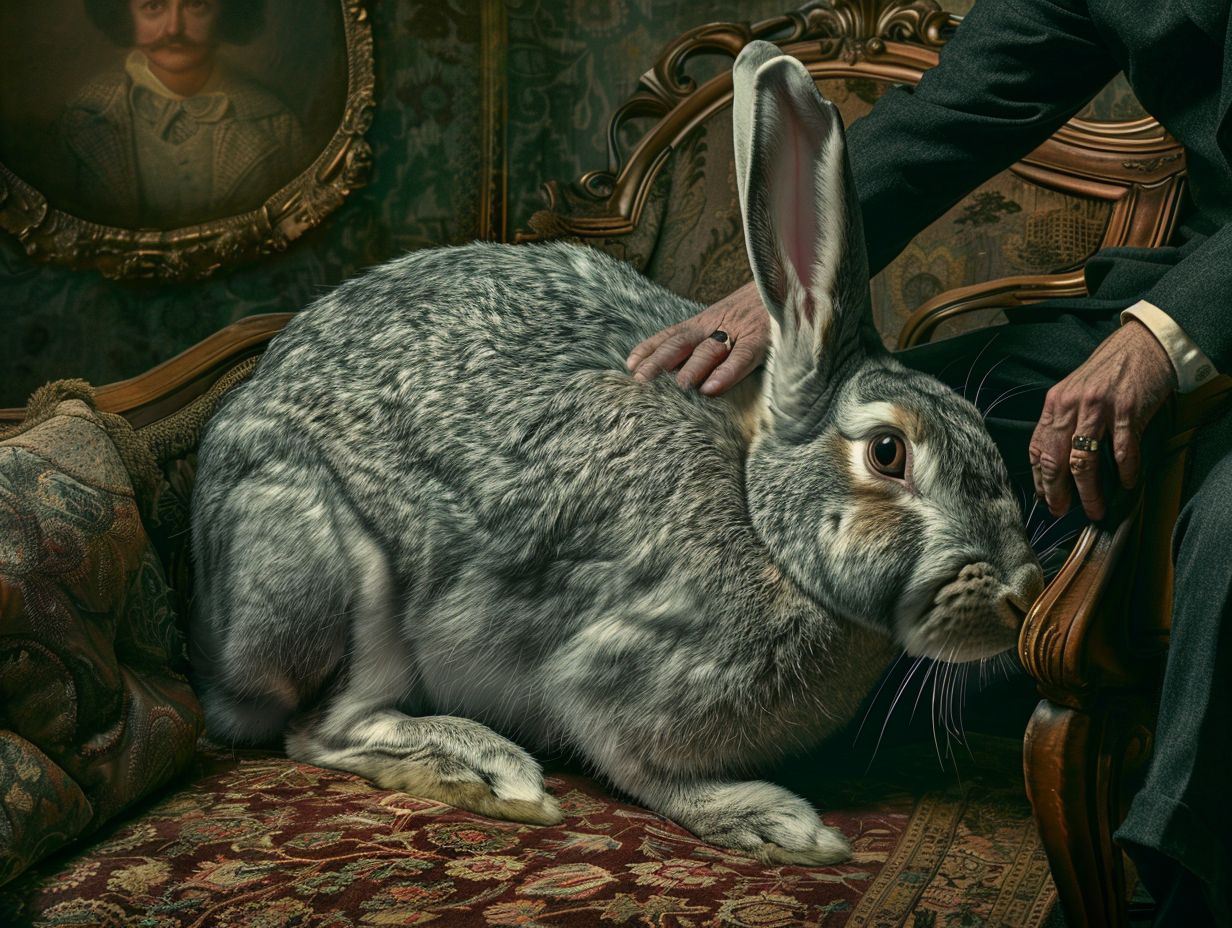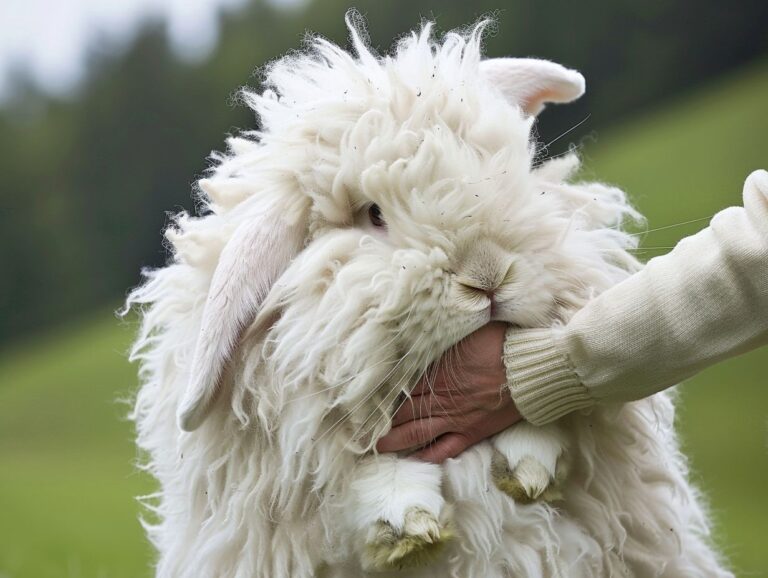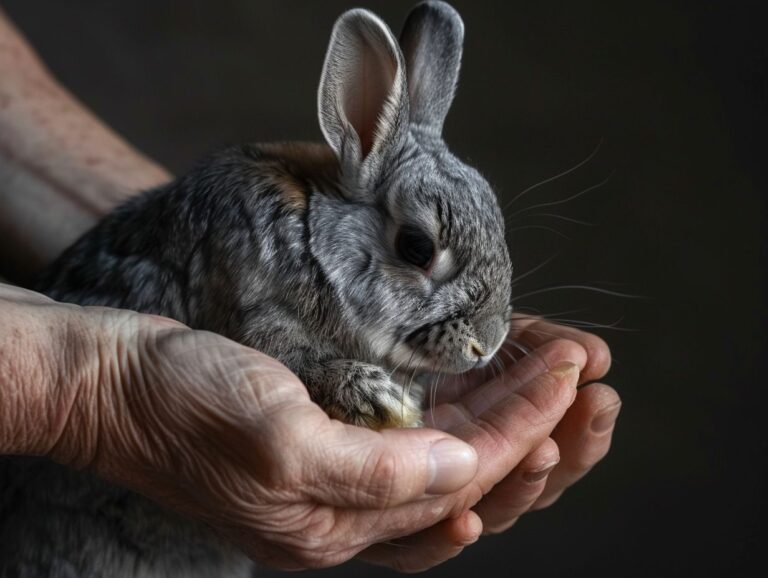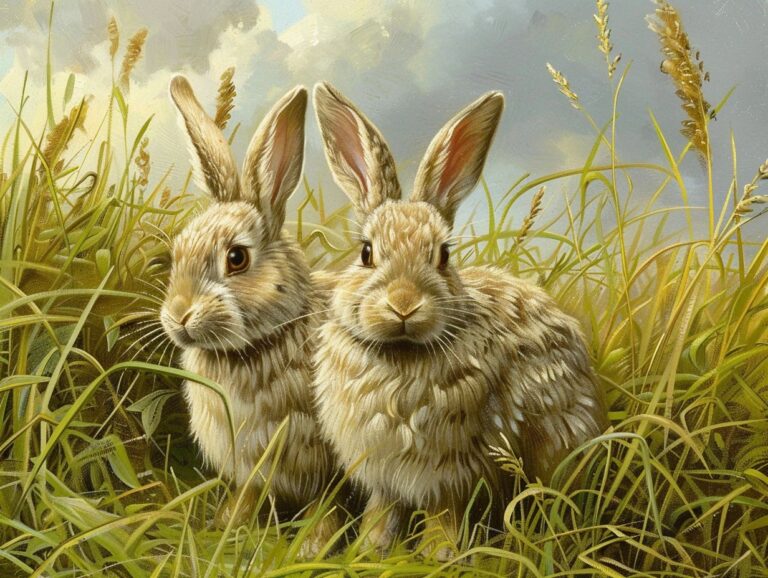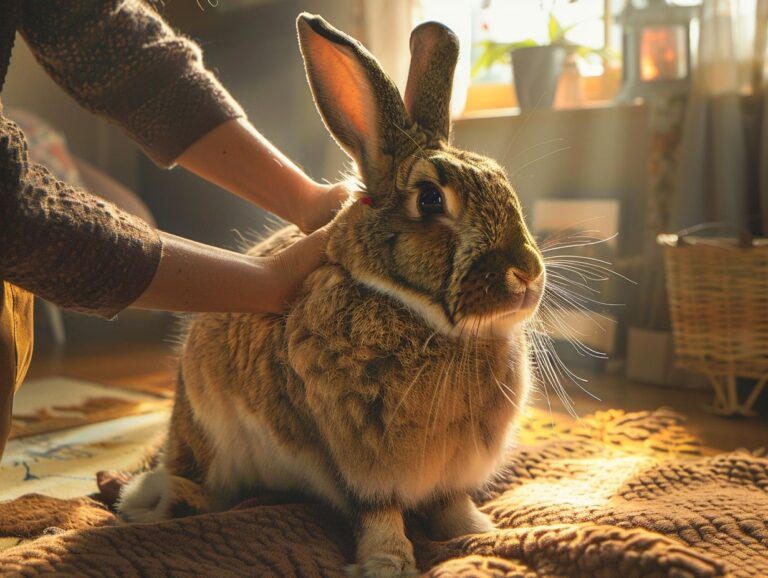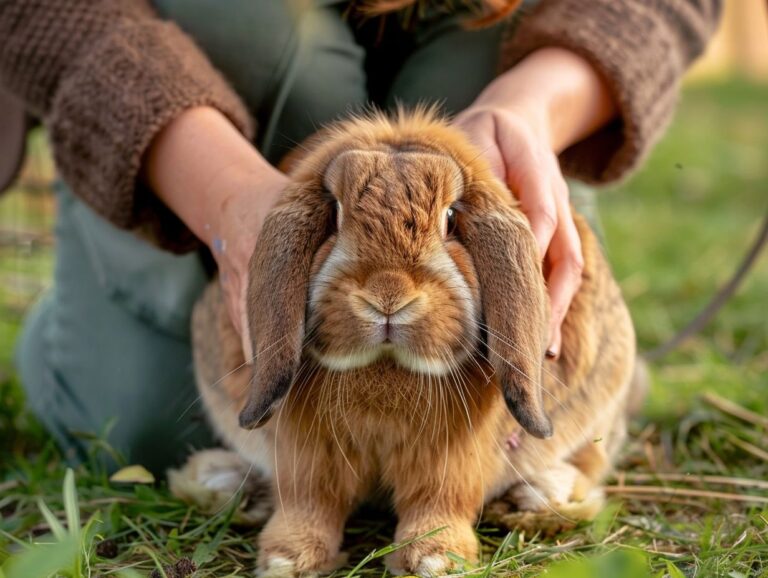Satin Rabbits As Pets: Care, Diet, and Health For Large Sized Breeds
Are you considering getting a large-sized rabbit breed as a pet? Satin rabbits are a popular choice due to their beautiful appearance and gentle nature.
We will explore the characteristics of Satin rabbits, their basic needs, common health issues, and how to care for them. From diet recommendations to grooming tips, we’ve got you covered on everything you need to know about keeping Satin rabbits happy and healthy.
Let’s dive in!
Key Takeaways:
What Are Large Sized Rabbit Breeds?
Large Sized Rabbit Breeds refer to breeds of rabbits that are typically bigger in size compared to other domestic breeds. These rabbits are known for their substantial body types and medium to large sizes.
One of the key characteristics of large-sized rabbit breeds is their impressive size and physical presence. These rabbits often exhibit robust build and muscular frames, setting them apart from smaller breeds. Their size can vary, with some breeds reaching up to 16 pounds or more. Large-sized rabbit breeds are known for their distinct features, such as long ears, broad heads, and strong hind legs, which contribute to their overall distinctive appearance.
How Big Are They?
Large-sized rabbit breeds typically range from medium to large sizes, with some breeds weighing between 9 to 11 pounds on average. Their body types often exhibit robust features and a sturdy build.
One of the well-known breeds falling within this weight range is the Flemish Giant, which can weigh up to 14 pounds or more. These rabbits are characterized by their large size and impressive muscular build. Another breed in this category is the British Giant, which can weigh around 12-14 pounds.
These larger rabbit breeds often have long bodies with powerful hind legs, allowing them to excel in activities like jumping and agility. The Checkered Giants also fall into this weight range, showcasing a sleek and elongated body type.
What Are the Characteristics of Satin Rabbits?
Satin Rabbits are known for their distinctive coat colors and the unique satin sheen that gives their fur a glossy appearance. These beautiful breeds are recognized for their striking coat types and colors.
The coat colors of Satin Rabbits vary widely, including shades of black, blue, red, chocolate, and more. What truly sets them apart is the satin sheen that makes their fur shine like silk under the light. This lustrous quality is particularly evident in rabbits with lighter-colored coats, enhancing their elegance. Satin Rabbits also exhibit different fur types, such as normal or rex coats, adding further diversity to their appearance and appeal.
What Makes Them Different from Other Rabbit Breeds?
What distinguishes Satin Rabbits from other rabbit breeds is the presence of a recessive gene mutation that results in the satin sheen of their fur. This unique satin gene sets them apart as one of the most beautiful breeds in the rabbit kingdom.
This satin gene not only adds a glossy sheen to their fur but also affects the texture, making it incredibly soft to touch. The way light plays off their coat gives Satin Rabbits a luxurious and almost ethereal appearance, captivating the eyes of all who see them. Due to the genetic mutation responsible for this unique satin coat, these rabbits tend to have a more elegant and refined look compared to other breeds, further accentuating their status as a breed of exceptional beauty.
What Are the Basic Needs of Satin Rabbits?
Satin Rabbits, like all rabbits, have specific basic needs that are essential for their well-being. Understanding their care requirements is crucial to ensuring they thrive in a domestic rabbitry setting.
One of the primary needs of Satin Rabbits is a balanced diet, consisting of high-quality hay, fresh vegetables, and a limited amount of pellet food to meet their nutritional requirements. Ensuring they have access to fresh water at all times is also vital for their health.
In terms of housing, Satin Rabbits require a spacious enclosure that allows them to hop, stretch, and exhibit natural behaviors. Providing hiding spots and bedding materials like straw or hay helps create a comfortable environment.
Exercise is crucial for Satin Rabbits to maintain good physical and mental health. Providing ample space for them to run and play, as well as engaging them in interactive toys and activities, helps fulfill their exercise needs.
Diet
A proper diet is essential for the health and well-being of Satin Rabbits, whether they are kept as pet rabbits or showcased in rabbit shows. Providing a balanced diet rich in nutrients is crucial for their overall health.
These rabbits require a diet that consists mainly of high-quality hay, fresh vegetables, and a limited amount of pellets. Hay is a fundamental component as it aids in digestion and keeps their teeth properly worn down. Fresh vegetables like dark leafy greens and root vegetables provide essential vitamins and minerals. Pellets should be given in moderation to avoid obesity and dental issues. Ensuring they have access to fresh water at all times is vital for their hydration and overall well-being.
Housing

For indoor housing, Satin Rabbits benefit from a spacious enclosure with plenty of room to hop and play. It’s important to choose a cage or pen with solid flooring to protect their delicate feet.
- Adding soft bedding materials like hay or wood shavings provides them with a cozy environment.
- Ensure good ventilation to maintain air quality.
When considering outdoor housing, a sturdy hutch or shelter is necessary to protect them from predators and harsh weather conditions.
- Constructing a secure fence around the outdoor area is crucial to prevent escape.
- Provide a shaded area and fresh water at all times for their comfort.
Exercise
Regular exercise is vital for the health and well-being of Satin Rabbits. Incorporating playtime and activities that promote movement and mental stimulation is essential to prevent health issues and ensure their overall well-being.
Satin Rabbits, like many other breeds, require adequate physical activity to maintain their health and prevent obesity-related problems. Engaging them in activities such as hopping around in a safe, spacious area or providing interactive toys can help meet their exercise needs. Mental stimulation is equally crucial for these intelligent animals. Ensuring that they have mental challenges through toys, puzzles, and social interaction can prevent boredom and promote their mental well-being.
- Grooming is another vital aspect of Satin Rabbit care. Their luxurious coat requires regular brushing to prevent tangling and matting. Pay special attention to their ears, as Rabbits are prone to ear mites.
- Regularly trimming their nails is important to avoid overgrowth, which can lead to discomfort and mobility issues. Combining grooming sessions with bonding time can help strengthen the bond between you and your furry companion.
By addressing their exercise, mental stimulation, and grooming needs, you can ensure that your Satin Rabbit leads a healthy, happy life.
What Are the Common Health Issues of Satin Rabbits?
While Satin Rabbits are generally good pets, they are prone to common health issues such as ear mites. Understanding these health concerns and knowing how to address them is crucial for maintaining the well-being of these beautiful breeds.
One of the common health problems that Satin Rabbits may encounter is digestive issues, which can result from improper diet or stress. Providing a balanced diet rich in hay, fresh vegetables, and limited pellets can help prevent gastrointestinal problems in these delicate creatures. Dental problems like overgrown teeth can also plague Satin Rabbits, so regular vet check-ups are essential to detect and address these issues early. By staying vigilant and proactive about their health, owners can ensure a long and happy life for their furry companions.
Gastrointestinal Stasis
One common health issue that Satin Rabbits may experience is gastrointestinal stasis, a condition that affects their digestive system. Recognizing the symptoms and seeking prompt veterinary care is essential to address this potentially serious health issue.
Gastrointestinal stasis in Satin Rabbits occurs when their digestive system slows down or stops functioning properly. This condition can be triggered by factors such as a diet low in fiber, dehydration, stress, or dental problems.
Prevention involves providing a balanced diet rich in hay, fresh water, and occasional leafy greens to support their digestive health for medium-sized breeds.
Common symptoms of gastrointestinal stasis in rabbits include reduced or absent fecal output, bloating, lethargy, and a lack of appetite. If left untreated, this condition can lead to serious complications such as gastrointestinal blockages.
Dental Problems
Dental problems, such as overgrowth or malocclusion, can be a concern for Satin Rabbits and impact their overall health. Regular dental check-ups and appropriate dental care are crucial to prevent and manage these issues effectively.
Satin Rabbits, like other breeds, have continuously growing teeth that need regular wear-down through chewing fibrous foods like hay. Without proper chewing, their teeth can become overgrown, causing pain and difficulty eating. Malocclusion, where the teeth don’t align correctly, can also lead to painful sores in the mouth. This highlights the importance of a balanced diet and adequate dental stimulation. By providing chew toys and monitoring their dental health closely, owners can help prevent severe dental issues in their Satin Rabbit companions.
Respiratory Infections
Respiratory infections can pose a significant health risk to Satin Rabbits, affecting their breathing and overall well-being. Recognizing the signs of respiratory issues and seeking appropriate veterinary care is crucial to manage and treat these infections effectively.
Common symptoms of respiratory infections in Rhinelander rabbits as pets include nasal discharge, sneezing, coughing, and labored breathing. These signs can progress rapidly, leading to severe respiratory distress if left untreated.
Prevention strategies such as maintaining a clean and well-ventilated living environment, providing a balanced diet rich in vitamin C, and avoiding exposure to smoke can help reduce the risk of these infections. Learn more about care for medium-sized rabbit breeds.
In cases where respiratory issues develop, timely intervention with antibiotics prescribed by a qualified veterinarian is essential to prevent complications and ensure the rabbit’s recovery.
How to Care for Satin Rabbits?
Proper care and attention are essential for ensuring the well-being of Satin Rabbits. From regular grooming to socialization and handling, providing the right care is crucial for these beautiful breeds.
Grooming plays a vital role in maintaining the luxurious coat of Satin Rabbits. Their distinctive fur requires gentle brushing at least twice a week to prevent matting and remove loose hair, promoting a healthy sheen. Regular nail trims are necessary to avoid overgrowth and discomfort. Socialization is crucial for their mental well-being, so spending quality time with them, engaging in interactive play, and providing a stimulating environment contribute to their happiness. When handling Satin Rabbits, it’s important to support their hindquarters to prevent injury and ensure they feel secure and comfortable.
Grooming

Regular grooming is essential for maintaining the health and appearance of Satin Rabbits’ fur. Brushing their coat, checking for any matting or parasites, and ensuring proper hygiene are vital aspects of their grooming routine.
Regular grooming not only helps in keeping their fur soft and lustrous but also plays a crucial role in preventing tangles and mats, which can lead to discomfort and skin issues. Satin Rabbits are prone to certain parasites like fleas and mites, so regular inspections during grooming can help detect and prevent infestations early on. Plus brushing, a gentle wipe-down with a damp cloth can help remove any dirt or debris, ensuring their skin stays clean and free from irritants.
Socialization
Socialization plays a crucial role in shaping the personality and behavior of Satin Rabbits. Providing opportunities for interaction, play, and mental stimulation is key to fostering a friendly and well-adjusted rabbit.
When Satin Rabbits are socialized properly, they are more likely to exhibit confident and friendly behaviors, making them easier to handle and interact with. By exposing them to various stimuli and experiences from a young age, owners can help prevent fearfulness and aggression later in life.
Introducing Satin Rabbits to different environments, people, and animals can help broaden their social skills and reduce the likelihood of developing anxious or skittish tendencies. Regular handling and positive reinforcement during socialization also play a crucial role in building trust and strengthening the bond between the rabbit and its owner.
Handling
Proper handling techniques are crucial for the health and safety of Satin Rabbits. Understanding how to hold and interact with them gently and securely is essential to prevent stress and injuries.
When handling Satin Rabbits, it’s important to approach them calmly and confidently. Start by supporting their body properly, ensuring the spine is well-supported to avoid any discomfort. Avoid sudden movements that could startle the rabbit, as they are sensitive creatures. Always approach from the front to allow them to see you coming, reducing the chance of frightening them. Establish a safe and quiet environment for handling to keep them relaxed and comfortable.
What Is the Recommended Diet for Satin Rabbits?
A well-rounded diet is essential for meeting the nutritional needs of Satin Rabbits. Including a variety of foods such as hay, vegetables, pellets, and occasional treats ensures they receive the essential nutrients for optimal health.
Hay is a crucial component of a Satin Rabbit’s diet, providing essential fiber to maintain digestive health. Fresh vegetables like lettuce, carrots, and kale offer important vitamins and minerals, contributing to overall well-being.
High-quality pellets specially formulated for rabbits help ensure they receive necessary proteins and other nutrients. Treats should be limited to prevent obesity and other health issues. It’s important to consult with a veterinarian to create a balanced diet plan tailored to your rabbit’s specific needs.
Hay
Hay is a fundamental component of the diet for Satin Rabbits, providing essential fiber and promoting healthy digestion. Offering high-quality hay regularly is crucial for their overall health and well-being.
Hay serves as a vital source of dietary fiber for Satin Rabbits, aiding in maintaining healthy digestive processes and preventing issues such as gastrointestinal stasis. The act of chewing on hay helps wear down their continuously growing teeth, ensuring proper dental health and reducing the risk of dental problems. Including a variety of hays like timothy hay, orchard grass, or meadow hay in their diet can offer a range of textures and flavors to keep them engaged and satisfied.
Vegetables
Incorporating a variety of fresh vegetables into the diet of Satin Rabbits provides essential vitamins and minerals for their overall health.
Offering a diverse selection of veggies ensures these fluffy companions receive a balanced and nutritious diet that supports their well-being.
Leafy greens
- like kale and spinach are rich in fiber, promoting digestive health and preventing gastrointestinal issues.
Carrots and bell peppers provide a crunchy texture while delivering important antioxidants and Vitamin C. Vegetables like broccoli and zucchini offer a range of nutrients that boost immunity and maintain a shiny coat. By including a spectrum of vegetables in their diet, Satin Rabbits can thrive and lead a vibrant life.
Pellets
Pellets are a concentrated source of nutrients that can supplement the diet of Satin Rabbits. Choosing high-quality pellets that are specifically formulated for rabbits ensures they receive essential vitamins and minerals.
Feeding pellets to Satin Rabbits is crucial in providing a balanced diet rich in fiber, proteins, and essential nutrients. These pellets play a vital role in meeting the rabbit’s dietary requirements, especially when fresh foods may not always provide adequate nutrition. Additionally, proper pellet selection ensures that the rabbits maintain a healthy weight and their digestive system functions optimally. It’s important to consider the nutritional balance of the pellets, as overfeeding may lead to obesity, while underfeeding can result in deficiencies.
Treats

While treats can be a delightful addition to the diet of Satin Rabbits, moderation is key to prevent overfeeding. Offering occasional treats such as fruits or small snacks can add variety to their diet and serve as rewards for good behavior.
It is important to remember that treats should only make up a small portion of a Satin Rabbit’s overall diet to ensure they receive essential nutrients from their main food. Opt for small breeds care tips natural, high-fiber options like leafy greens, broccoli, or small amounts of fruits like apples or berries. These treats not only provide enrichment and mental stimulation but also aid in digestive health.
Frequently Asked Questions
1. What is the average size of a Satin rabbit, and are they considered a large breed?
Satin rabbits typically weigh between 9 to 11 pounds, making them a large-sized breed.
2. How often should I groom my Satin rabbit to keep their coat healthy?
Satin rabbits have a unique, silky coat that requires regular grooming. We recommend brushing them at least once a week to keep their coat shiny and tangle-free.
3. What type of diet is suitable for large-sized Satin rabbits?
Large-sized Satin rabbits have specific dietary needs and should be fed a high-quality pellet-based diet, along with fresh hay and leafy greens. Consult with a veterinarian for a recommended feeding schedule.
4. What are common health concerns for large-sized Satin rabbits?
Some health issues that large-sized Satin rabbits may be prone to include overgrown teeth, obesity, and gastrointestinal problems. It is essential to monitor their diet and seek veterinary care if you notice any concerning symptoms.
5. Do Satin rabbits need a lot of space to thrive as pets?
Like any rabbit breed, Satins require ample space to hop, play, and exercise. It is recommended to provide a large enclosure or designated play area for your Satin rabbit to stay active and healthy.
6. How can I bond with my large-sized Satin rabbit and create a strong bond?
Spending quality time with your Satin rabbit, such as regular grooming sessions and playtime, can help strengthen your bond. Additionally, offering healthy treats and speaking to them in a calm and gentle tone can also help build trust and a strong relationship.

